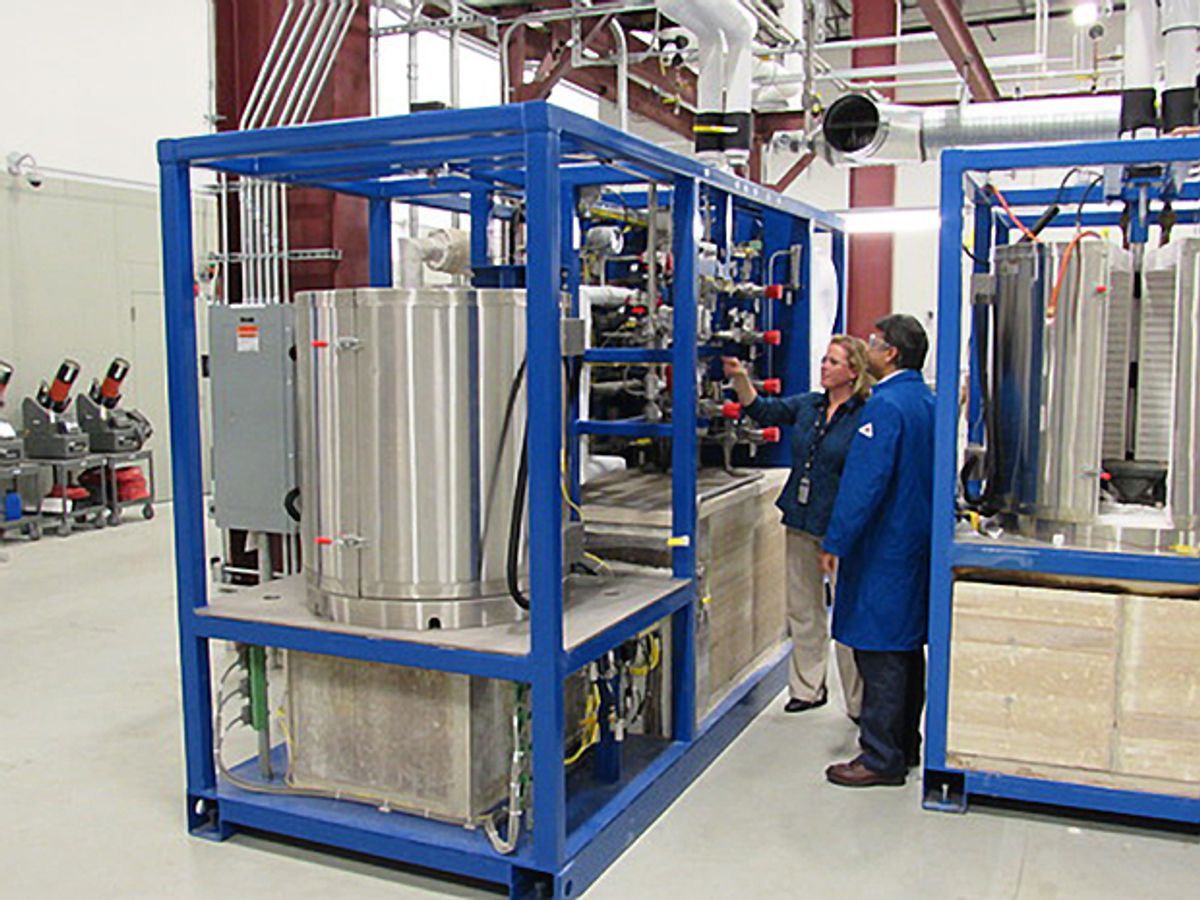General Electric has developed a way to convert natural gas using a combination of fuel cell and an engine, an approach it hopes will finally result in broad adoption of stationary fuel cells.
The industrial giant's research arm on Tuesday disclosed details on its solid-oxide fuel cell research efforts and said it has started a pilot line at a factory in upstate New York to manufacture the generators. As first reported here last year, GE has achieved relatively high efficiency by coupling two generators and hopes to bring down costs by using cheaper materials.
Instead of using expensive platinum or other rare metals as catalysts, GE's fuel cell uses stainless steel, the company says. It generates electricity by flowing fuel through stacks of ceramic plates where a chemical reaction between the fuel and oxygen from incoming air occurs between a positive and negative electrode at high temperatures.
The core technical innovation lies in the ceramic plates, GE materials scientist Kristen Brosnan said in a statement. The anode and zirconium-oxide electrolyte layers are deposited using a thermal spray technology now used to protect parts inside GE jet engines. The cathode is a printable ceramic material GE developed. "Our materials are easy to apply, can handle large temperature swings and last a long time," says Brosnan.
GE engineers have also taken advantage of another generator in its product portfolio—its Jenbacher gas engine—to squeeze more electricity from the available fuel. The natural gas-to-electricity conversion produces exhaust gases, which contain a mixture of hydrogen and carbon. This synthetic gas, or syngas, is fed into the engine to produce additional power. Combined, GE estimates it can turn 65 percent of the usable energy from natural gas into electricity. Bloom Energy, which also makes a solid-oxide fuel cell, says its fuel cells are about 60 percent efficient. Using the waste heat from this process, GE thinks it can get to 95 percent energy efficiency.
In the U.S., there has been a surge in interest in distributed power generation and microgrids in the wake of Hurricane Sandy and other storms, which knocked out power for long periods of time. Fuel cells, which compete with micro-turbines and engines for distributed power, are considered reliable for baseload power generation but tend to be more expensive per kilowatt.
Improving the efficiency of power conversion is one way to make fuel cells more cost competitive with other sources of distributed power generation. The low cost of natural gas in the U.S, thanks to a drilling boom, is also making distributed generation more competitive compared to grid power.
Stationary fuel cells are already being used in places, such as wastewater treatment plants or commercial buildings that want a reliable source of power. eBay and Apple have both installed multi-megawatt fuel cells from Bloom Energy at their cutting-edge data centers. Some utilities, too, are experimenting with using distributed fuel cells to generate power locally rather than from central power plants.
For its part, GE is bullish on natural gas for distributed energy. Its research organization is developing a number of products, such as liquid and compressed natural gas fueling stations for vehicles and on-site power generation. Its fuel cells, which can generate between one megawatt and ten megawatts, could be used to power remote industrial sites, such as mining operations or drilling, and locations that lack the electric grid but have access to local natural gas sources.
At a commercial level, though, fuel-cell companies have tended to struggle financially. Earlier this week, for instance, fuel-cell maker ClearEdge Power, which had declared bankruptcy earlier this year, was bought by a South Korean conglomerate after failing to attract enough customers.
GE faces the same financial hurdles as other fuel cell companies but with its hybrid approach, can boast improved performance. And with its financial resources, it can continue to refine the technology and manufacturing over time and provide financing to customers who would rather pay for the power generated by fuel cells than purchase the equipment themselves.



